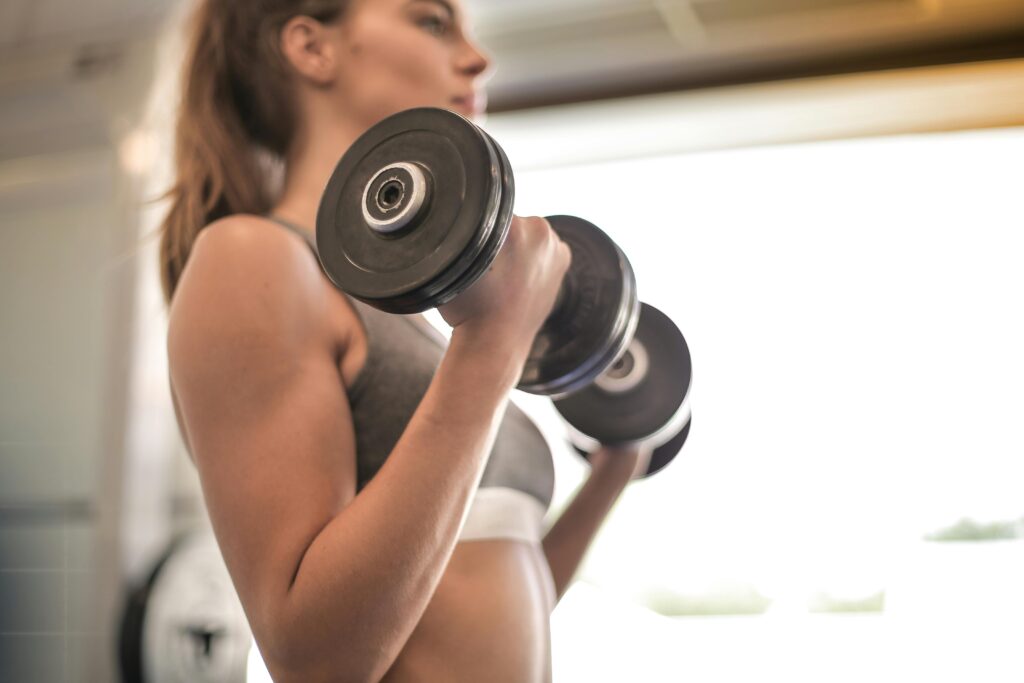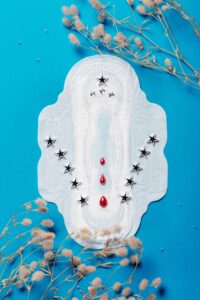Hair
Have you heard that stress makes your hair fall out? That’s likely due to the rise in cortisol that can target and damage hair follicles, leading to hair loss. When it comes to reproductive health though, two significant events that can affect our health are pregnancy and menopause. The increase in oestrogen and progesterone during pregnancy leads to hair growth and strength, nurturing the hair and preventing hair loss. Once those hormone levels balance out post-pregnancy or decrease significantly in the case of menopause, it can lead to hair loss (Grymowicz et al., 2020).

On the other side of the spectrum, we have hirsutism (excessive hair growth). This condition is often a symptom of polycystic ovarian syndrome (PCOS) and refers to the excessive growth of dark, coarse hair over areas of the body in which it wouldn’t usually grow, such as the face and back. Around 1 in 10 women experience hirsutism (Department of Health, State Government of Victoria, 2021).
Face
Pimples and acne, yes…you know the ones, those annoying, red, inflamed and often sore marks on your face that sometimes show up at the most inconvenient of times, like your graduation or before a date. Acne can be due to a range of underlying causes, but we’ll just touch on the hormonal underpinnings.

Adult acne, often called hormonal acne, is mostly linked to the overproduction of sebum (an oily substance in skin glands). The sebum clogs pores and creates pimples (Bagatin et al.,2019). While there is a lot that can cause acne, one of the key underlying causes is hormonal imbalance. Around 60-70% of women experience worsening acne in their premenstrual period, as a result of the increase in oestrogen.
Breasts
If you experience increased soreness or sensitivity in your breasts throughout the menstrual cycle, it is completely normal! Once again, the increase in oestrogen can lead to breast soreness which can be in the lead up to your period or at other stages of your cycle. These hormones can also create swelling that affects the size or shape of your breasts (The Royal Women’s Hospital, 2023).
Muscle Strength

While there isn’t enough research done in this space, many people have reported that they experience varying levels of muscle strength throughout their menstrual cycle. There are some really interesting studies with female athletes happening in this field. In a small study with female AFL players, their fatigue was significantly higher and sleep quality worse during the luteal phase, which in turn affected their training capacity (Charmichael et al.,2021). Another review revealed that while objective performance remained relatively consistent, it was the perception of physical performance that affected how female athletes felt during their luteal phase (Charmichael, Thomson, Moran and Wycherley, 2021)
Now that we have some information about how our reproductive hormones affect us, the hope is that this knowledge gives you the courage to reflect on some ways your hormonal balance may impact each of these areas of your physical health. If you notice that something isn’t at the level you’d like it to be, we encourage you to think of what you could do to shift that. It could be that you implement some lifestyle changes (i.e. sleeping habits, nutrition, exercise) or that you consider seeing a health professional. Some fantastic books discuss this, Dr. Jolene Bright is seen as a lead voice on this topic.
Before we end, I want to bring back the disclaimer we gave you in an earlier post. While we have delved deep into research to bring you this information in the most accurate and evidence-based way we could, we are not health professionals. Your doctors know what is best for you and your individual conditions.
If you take away just one thing from reading this post, let it be that our reproductive hormones affect our bodies in heaps of ways beyond reproductive functions. It is incredibly helpful to pay attention at how our hormones affect different aspects of our physical health even if only to see just how interesting it is! Understanding how our hormones affect our bodies gives us the ability to “hack” our health to gives us an added boost.
References
Bagatin, E., Freitas, T. H. P., Rivitti-Machado, M. C., Machado, M. C. R., Ribeiro, B. M., Nunes, S., & Rocha, M. A. D. D. (2019). Adult female acne: a guide to clinical practice. Anais brasileiros de dermatologia, 94(1), 62–75. https://doi.org/10.1590/abd1806-4841.20198203
Better Health Victoria (n.d.). Polycystic Ovarian Syndrome (PCOS). Retrieved from https://www.betterhealth.vic.gov.au/health/conditionsandtreatments/polycystic-ovarian-syndrome-pcos. Accessed on 26 February 2024.
Carmichael, M.A.; Thomson, R.L.; Moran, L.J.; Dunstan, J.R.; Nelson, M.J.; Mathai, M.L.;
Wycherley, T.P. A Pilot Study on the Impact of Menstrual Cycle Phase on Elite Australian Football Athletes. Int. J. Environ. Res. Public Health 2021, 18,9591. https://doi.org/10.3390/ijerph18189591
Carmichael, M.A.; Thomson, R.L.; Moran, L.J.; Wycherley, T.P. The Impact of Menstrual Cycle Phase on Athletes’ Performance: A Narrative Review. Int. J. Environ. Res. Public Health 2021, 18, 1667. https://doi.org/10.3390/ijerph18041667
Grymowicz, M., Rudnicka, E., Podfigurna, A., Napierala, P., Smolarczyk, R., Smolarczyk, K., & Meczekalski, B. (2020). Hormonal Effects on Hair Follicles. International journal of molecular sciences, 21(15), 5342. https://doi.org/10.3390/ijms21155342
The Royal Women’s Hospital, Victoria, Australia. (2023). Breast Soreness. https://www.thewomens.org.au/health-information/breast-health/breast-soreness#:~:text=The%20most%20common%20hormonal%20breast,and%20sometimes%20right%20through%20it.
Handy, A. B., Greenfield, S. F., Yonkers, K. A., & Payne, L. A. (2022). Psychiatric symptoms across the menstrual cycle in adult women: A comprehensive review. Harvard Review of Psychiatry, 30(2), 100–117. doi:10.1097/hrp.0000000000000329
Healthdirect Australia (2023). Endometriosis. Retrieved from https://www.healthdirect.gov.au/endometriosis#symptoms. Accessed 26 February 2024.
Jean Hailes (2023). PMDD: PMS: Premenstrual dysphoric disorder. Retrieved from https://www.jeanhailes.org.au/health-a-z/periods/premenstrual-syndrome-pms#what-is-pms. Accessed 26 February 2024.
Jean Hailes (2023b). Endometriosis. Retrieved from https://www.jeanhailes.org.au/health-a-z/endometriosis/diagnosis#:~:text=The%20average%20time%20to%20get,symptoms%20such%20as%20pelvic%20pain.Accessed 26 February 2024.
Queensland Health, The State of Queensland (2023). Breaking the cycle: A guide to understanding and managing premenstrual dysphoric disorder (PMDD). Retrieved from https://www.health.qld.gov.au/news-events/news/breaking-the-cycle-a-guide-to-understanding-and-managing-premenstrual-dysphoric-disorder-pmdd . Accessed 26 February 2024.
Women’s Health & Research Institute of Australia (n.d.). Polycystic Ovarian Syndrome. Retrieved from https://www.whria.com.au/for-patients/hormones/polycystic-ovarian-syndrome/. Accessed on 26 February 2024.
World Health Organisation (2023). Endometriosis. Retrieved from https://www.who.int/news-room/fact-sheets/detail/endometriosis#:~:text=Key%20facts,age%20women%20and%20girls%20globally. Accessed 26 February 2024.



